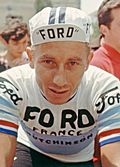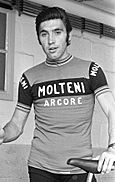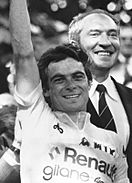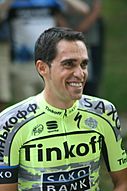Grand Tour (cycling) facts for kids
- For other uses see Grand Tour
In road bicycle racing, a Grand Tour is one of the three biggest professional cycling races in Europe. These are the Giro d'Italia, the Tour de France, and the Vuelta a España. They are all called Grand Tours together. All three races are similar. They last for three weeks with a new stage each day.
These races are very important in cycling rules. They give more points for the UCI World Tour than other races. They are also the only stage races allowed to last longer than 14 days.
All three races have a long history. The Tour de France started in 1903. The Giro d'Italia began in 1909. The Vuelta a España first took place in 1935. The Giro is usually in May. The Tour is in July. The Vuelta is in late August and September. The Vuelta used to be in spring. But in 1995, it moved to September. This was to avoid racing at the same time as the Giro d'Italia.
The Tour de France is the oldest and most famous of the three. It gives the most points to riders. It is also the most watched yearly sports event in the world. Winning the Tour, the Giro, and the Road World Cycling Championship is called the Triple Crown of Cycling.
The three Grand Tours are for men. As of 2023, there are no three-week races for women. However, the Vuelta Femenina, Giro Donne, and Tour de France Femmes are similar races for women. They are shorter, usually about a week long. The Giro Donne started in 1988. Women's Tour de France events have happened since 1984. The Tour de France Femmes had its first race in 2022.
Contents
About Grand Tours
Grand Tours are held over three weeks in a row. They usually have two rest days. These breaks are near the start of the second and third weeks. Sometimes there is an extra rest day. This happens if the race starts far from its home country.
Each day's race is called a stage. Stages can be long mass-start races. Some stages include big climbs and descents. Others are flat stages. These flat stages are good for sprinters. There are also individual and team time trials. Most stages are under 200 kilometers long.
Rules for Grand Tours
The Union Cycliste Internationale (UCI) has special rules for Grand Tours. These races give more points for the UCI World Tour. For example, the Tour de France winner gets 1000 points. The Giro and Vuelta winners get 850 points. Points for other races are different.
Grand Tours can last between 15 and 23 days. Other stage races cannot last longer than 14 days. This makes Grand Tours special.
Teams in Grand Tours
All top-level teams, called UCI WorldTeams, must join these races. Race organizers can also invite other teams. These are called wildcard teams. This makes sure about 22 teams compete in each Grand Tour.
Different Competitions
The main goal is to win the overall race. This is called the general classification. It is decided by adding up each rider's time. Sometimes, time bonuses are given. There are also other awards. These include best team and best young rider. Riders also compete for climbing and sprinting points.
Five riders have won the overall, mountains, and points awards in the same race. These are Eddy Merckx, Tony Rominger, Laurent Jalabert, Marco Pantani, and Tadej Pogačar.
Riders and Their Achievements
It is rare for cyclists to ride all three Grand Tours in one year. In 2004, only two cyclists started all three. It is more common for sprinters to start all three. They aim to win stages before the hardest parts of the race.
34 riders have finished all three Grand Tours in one year. Adam Hansen did this six years in a row! Only two riders have finished in the top 10 in all three tours in the same year. They are Raphaël Géminiani (1955) and Gastone Nencini (1957).
Riders from the same country have won all three Grand Tours in one year three times. French riders did it in 1964. Spanish riders did it in 2008. In 2018, three different British riders won each Tour. These were Chris Froome, Geraint Thomas, and Simon Yates.
Four times, a home rider won each Grand Tour. This means an Italian won the Giro, a Frenchman won the Tour, and a Spaniard won the Vuelta. The last time this happened was in 1975.
Women's Grand Tour Events
As of 2023, there are no three-week races for women. But women have raced in long stage races before. Various women's Tour de France events have happened since 1984.
Today, the Giro Donne (started 1988), Tour de France Femmes (started 2022), and Vuelta Femenina (started 2015) are seen as the women's equivalent. These races are shorter, usually about a week long. The Vuelta Femenina is in May. The Giro Donne is in late June or early July. The Tour de France Femmes is in late July, after the men's Tour.
Some people call these women's races "Grand Tours." They are the biggest events in women's cycling. However, they are not three weeks long. They also do not have special rules like the men's Grand Tours. Some argue that these races need more high mountain stages or time trials to be truly equal.
Groups like Le Tour Entier and The Cyclists' Alliance are working to make women's races longer. They also want to improve how women's cycling is supported. This could help women have three-week races in the future.
General Classification Winners
Wins Each Year
| Key | |
|---|---|
| Rider won 3 Grand Tours in the same year | |
| Rider won 2 Grand Tours in the same year | |
| Flag key: National Flags | |
| Year | |||
|---|---|---|---|
| 1903 | started in 1909 | started in 1935 | |
| 1904 | |||
| 1905 | |||
| 1906 | |||
| 1907 | |||
| 1908 | |||
| 1909 | |||
| 1910 | |||
| 1911 | |||
| 1912 | Giovanni Micheletto (1/1) & Eberardo Pavesi (1/1)) |
||
| 1913 | |||
| 1914 | |||
| 1915 | Not held during World War I | ||
| 1916 | |||
| 1917 | |||
| 1918 | |||
| 1919 | |||
| 1920 | |||
| 1921 | |||
| 1922 | |||
| 1923 | |||
| 1924 | |||
| 1925 | |||
| 1926 | |||
| 1927 | |||
| 1928 | |||
| 1929 | |||
| 1930 | |||
| 1931 | |||
| 1932 | |||
| 1933 | |||
| 1934 | |||
| 1935 | |||
| 1936 | |||
| 1937 | Not held during the Spanish Civil War | ||
| 1938 | |||
| 1939 | |||
| 1940 | Not held during World War II | ||
| 1941 | Not held during World War II | ||
| 1942 | |||
| 1943 | Not held during World War II | ||
| 1944 | |||
| 1945 | |||
| 1946 | |||
| 1947 | |||
| 1948 | |||
| 1949 | Not held for lack of interest | ||
| 1950 | |||
| 1951 | Not held for lack of interest | ||
| 1952 | |||
| 1953 | |||
| 1954 | |||
| 1955 | |||
| 1956 | |||
| 1957 | |||
| 1958 | |||
| 1959 | |||
| 1960 | |||
| 1961 | |||
| 1962 | |||
| 1963 | |||
| 1964 | |||
| 1965 | |||
| 1966 | |||
| 1967 | |||
| 1968 | |||
| 1969 | |||
| 1970 | |||
| 1971 | |||
| 1972 | |||
| 1973 | |||
| 1974 | |||
| 1975 | |||
| 1976 | |||
| 1977 | |||
| 1978 | |||
| 1979 | |||
| 1980 | |||
| 1981 | |||
| 1982 | |||
| 1983 | |||
| 1984 | |||
| 1985 | |||
| 1986 | |||
| 1987 | |||
| 1988 | |||
| 1989 | |||
| 1990 | |||
| 1991 | |||
| 1992 | |||
| 1993 | |||
| 1994 | |||
| 1995 | |||
| 1996 | |||
| 1997 | |||
| 1998 | |||
| 1999 | No winner | ||
| 2000 | No winner | ||
| 2001 | No winner | ||
| 2002 | No winner | ||
| 2003 | No winner | ||
| 2004 | No winner | ||
| 2005 | No winner | ||
| 2006 | |||
| 2007 | |||
| 2008 | |||
| 2009 | |||
| 2010 | |||
| 2011 | |||
| 2012 | |||
| 2013 | |||
| 2014 | |||
| 2015 | |||
| 2016 | |||
| 2017 | |||
| 2018 | |||
| 2019 | |||
| 2020 | |||
| 2021 | |||
| 2022 | |||
| 2023 | |||
| Year | |||
A. Lance Armstrong was named the winner of seven Tours from 1999 to 2005. However, he was later stripped of all his titles. This happened in 2012 due to his use of performance-enhancing drugs. The Tour de France organizers decided to leave those winner spots empty.
Wins by Rider
| Rank | Rider | Total | Tour | Giro | Vuelta |
|---|---|---|---|---|---|
| 1 | 11 | 5 (1969, 1970, 1971, 1972, 1974) | 5 (1968, 1970, 1972, 1973, 1974) | 1 (1973) | |
| 2 | 10 | 5 (1978, 1979, 1981, 1982, 1985) | 3 (1980, 1982, 1985) | 2 (1978, 1983) | |
| 3 | 8 | 5 (1957, 1961, 1962, 1963, 1964) | 2 (1960, 1964) | 1 (1963) | |
| 4 | 7 | 2 (1949, 1952) | 5 (1940, 1947, 1949, 1952, 1953) | – | |
| 7 | 5 (1991, 1992, 1993, 1994, 1995) | 2 (1992, 1993) | – | ||
| 7 | 2 (2007, 2009) | 2 (2008, 2015) | 3 (2008, 2012, 2014) | ||
| 7 | 4 (2013, 2015, 2016, 2017) | 1 (2018) | 2 (2011, 2017) | ||
| 8 | 5 | – | 5 (1925, 1927, 1928, 1929, 1933) | – | |
| 5 | 2 (1938, 1948) | 3 (1936, 1937, 1946) | – | ||
| 5 | 1 (1965) | 3 (1967, 1969, 1976) | 1 (1968) | ||
| 11 | 4 | – | 1 (1995) | 3 (1992, 1993, 1994) | |
| 4 | – | – | 4 (2000, 2003, 2004, 2005) | ||
| 4 | 1 (2014) | 2 (2013, 2016) | 1 (2010) | ||
| 4 | – | 1 (2023) | 3 (2019, 2020, 2021) |
- Active riders are in bold.
Wins by Country
| Country | Giro | Tour | Vuelta | Total |
|---|---|---|---|---|
| 69 | 10 | 6 | 85 | |
| 6 | 36 | 9 | 51 | |
| 4 | 12 | 32 | 48 | |
| 7 | 18 | 8 | 33 | |
| 2 | 6 | 3 | 11 | |
| 3 | 2 | 5 | 10 | |
| 2 | 5 | 0 | 7 | |
| 1 | 2 | 3 | 6 | |
| 1 | 3 | 2 | 6 | |
| 1 | 2 | 2 | 5 | |
| 2 | 1 | 2 | 5 | |
| 0 | 1 | 3 | 4 | |
| 3 | 0 | 1 | 4 | |
| 0 | 3 | 0 | 3 | |
| 1 | 1 | 1 | 3 | |
| 1 | 1 | 0 | 2 | |
| 1 | 0 | 0 | 1 | |
| 1 | 0 | 0 | 1 | |
| 1 | 0 | 0 | 1 | |
| 0 | 0 | 1 | 1 |
Winners of All Three Grand Tours
Seven cyclists have won all three Grand Tours in their careers:
 Jacques Anquetil: 5 Tours, 2 Giros, 1 Vuelta.
Jacques Anquetil: 5 Tours, 2 Giros, 1 Vuelta. Felice Gimondi: 1 Tour, 3 Giros, 1 Vuelta.
Felice Gimondi: 1 Tour, 3 Giros, 1 Vuelta. Eddy Merckx: 5 Tours, 5 Giros, 1 Vuelta.
Eddy Merckx: 5 Tours, 5 Giros, 1 Vuelta. Bernard Hinault: 5 Tours, 3 Giros, 2 Vueltas.
Bernard Hinault: 5 Tours, 3 Giros, 2 Vueltas. Alberto Contador: 2 Tours, 2 Giros, 3 Vueltas.
Alberto Contador: 2 Tours, 2 Giros, 3 Vueltas. Vincenzo Nibali: 1 Tour, 2 Giros, 1 Vuelta.
Vincenzo Nibali: 1 Tour, 2 Giros, 1 Vuelta. Chris Froome: 4 Tours, 1 Giro, 2 Vueltas.
Chris Froome: 4 Tours, 1 Giro, 2 Vueltas.
Hinault and Contador are the only ones to win each Grand Tour at least twice.
Winners of Multiple Grand Tours in One Year
Ten riders have won two Grand Tours in the same year. Seven cyclists have won the Tour and the Giro in the same year:
 Fausto Coppi: 1949, 1952
Fausto Coppi: 1949, 1952 Jacques Anquetil: 1964
Jacques Anquetil: 1964 Eddy Merckx: 1970, 1972, 1974
Eddy Merckx: 1970, 1972, 1974 Bernard Hinault: 1982, 1985
Bernard Hinault: 1982, 1985 Stephen Roche: 1987
Stephen Roche: 1987 Miguel Induráin: 1992, 1993
Miguel Induráin: 1992, 1993 Marco Pantani: 1998
Marco Pantani: 1998
Three cyclists have won the Tour and the Vuelta in the same year:
 Jacques Anquetil: 1963
Jacques Anquetil: 1963 Bernard Hinault: 1978
Bernard Hinault: 1978 Chris Froome: 2017
Chris Froome: 2017
Three cyclists have won the Giro and the Vuelta in the same year:
 Eddy Merckx: 1973
Eddy Merckx: 1973 Giovanni Battaglin: 1981
Giovanni Battaglin: 1981 Alberto Contador: 2008
Alberto Contador: 2008
Smallest Winning Margins
The difference in time between the winner and second place is often very small. It is rarely more than a few minutes. As of 2021, 54 Grand Tours have been won by less than one minute. Here are some of the closest finishes:
| Rank | Winner | Time | Runner-up | Margin | Race |
|---|---|---|---|---|---|
| 1 | 90h 08' 03"" | +00h 00' 06" | Vuelta a España (1984) | ||
| 2 | 87h 38' 35" | +00h 00' 08" | Tour de France (1989) | ||
| 3 | 86h 48' 18" | +00h 00' 11" | Vuelta a España (1974) | ||
| 124h 51' 52" | Giro d'Italia (1948) | ||||
| 5 | 113h 08' 13" | +00h 00' 12" | Giro d'Italia (1974) | ||
| 6 | 105h 37' 52" | +00h 00' 13" | Vuelta a España (1956) | ||
| 108h 56' 12" | Giro d'Italia (1955) | ||||
| 8 | 88h 00" 56' | +00h 00' 14" | Vuelta a España (1975) | ||
| 85h 29" 02' | Giro d'Italia (2023) | ||||
| 10 | 91h 39' 02" | +00h 00' 16" | Giro d'Italia (2012) |
The biggest winning margin ever was in the first Tour de France in 1903. Maurice Garin won by almost 3 hours! In the Giro d'Italia, the biggest margin was in 1914. Alfonso Calzolari won by nearly 2 hours. For the Vuelta a España, Delio Rodríguez won by over 30 minutes in 1945.
Grand Tour Stage Wins
Three cyclists have won stages in all three Grand Tours in the same year. These are Miguel Poblet (1956), Pierino Baffi (1958), and Alessandro Petacchi (2003).
This list includes wins up to the 2023 Tour de France. Riders in bold are still racing.
| Rank | Rider | Tour | Giro | Vuelta | Total |
|---|---|---|---|---|---|
| 1 | 34 | 24 | 6 | 64 | |
| 2 | 12 | 42 | 3 | 57 | |
| 3 | 34 | 17 | 3 | 54 | |
| 4 | 6 | 22 | 20 | 48 | |
| 5 | 2 | 41 | 0 | 43 | |
| 6 | 28 | 6 | 7 | 41 | |
| 7 | 8 | 31 | 0 | 39 | |
| 8 | 0 | 0 | 39 | 39 | |
| 9 | 7 | 12 | 18 | 37 | |
| 10 | 15 | 7 | 13 | 35 | |
| 11 | 9 | 22 | 0 | 31 | |
| 12 | 0 | 30 | 0 | 30 | |
| 13 | 12 | 17 | 0 | 29 | |
| 14 | 6 | 15 | 6 | 27 | |
| 2 | 23 | 2 | 27 | ||
| 16 | 6 | 16 | 4 | 26 | |
| 11 | 15 | 0 | 26 | ||
| 3 | 20 | 3 | 26 | ||
| 0 | 24 | 2 | 26 | ||
| 20 | 4 | 21 | 0 | 25 | |
| 4 | 3 | 18 | 25 | ||
| 25 | 0 | 0 | 25 | ||
| 4 | 15 | 6 | 25 | ||
| 24 | 1 | 22 | 1 | 24 | |
| 12 | 12 | 0 | 24 | ||
| 26 | 22 | 1 | 0 | 23 | |
| 27 | 16 | 5 | 1 | 22 | |
| 9 | 4 | 9 | 22 | ||
| 11 | 7 | 4 | 22 | ||
| 30 | 10 | 11 | 0 | 21 | |
| 5 | 0 | 16 | 21 | ||
| 3 | 5 | 13 | 21 |
The rider with the most Grand Tour stage wins in one season is Freddy Maertens. He won 20 stages in 1977. This included 13 stages in the Vuelta a España and 7 in the Giro d'Italia.
Grand Tour Finishers
Only 35 riders have finished all three Grand Tours in one season. Adam Hansen did this an amazing six times in a row! Marino Lejarreta did it four times. Bernardo Ruiz achieved it in three different years. Eduardo Chozas and Carlos Sastre completed this feat twice.
The rider with the most Grand Tour appearances is Matteo Tosatto with 34. He finished 28 of them. Adam Hansen holds the record for finishing the most Grand Tours in a row. He finished 20 tours from the 2011 Vuelta a España to the 2018 Giro d'Italia.
The best average finish for all three Grand Tours in one season was by Raphaël Géminiani in 1955. He finished 4th in the Giro, 6th in the Tour, and 3rd in the Vuelta.
| Rider | Year | Final GC position | ||
|---|---|---|---|---|
| Giro | Tour | Vuelta | ||
| 2023 | 14 | 12 | 1 | |
| 2019 | 51 | 60 | 56 | |
| 2017 | 93 | 113 | 95 | |
| 2016 | 3 | 6 | 12 | |
| 2016 | 68 | 100 | 110 | |
| 2015 | 36 | 54 | 47 | |
| 2015 | 77 | 114 | 55 | |
| 2014 | 73 | 64 | 53 | |
| 2013 | 72 | 72 | 60 | |
| 2012 | 94 | 81 | 123 | |
| 2011 | 56 | 113 | 77 | |
| 2010 | 8 | 20 | 8 | |
| 2009 | 136 | 121 | 132 | |
| 2008 | 3 | 27 | 10 | |
| 2008 | 80 | 43 | 49 | |
| 2007 | 20 | 70 | 28 | |
| 2006 | 43 | 4 | 4 | |
| 2005 | 88 | 118 | 114 | |
| 2001 | 58 | 69 | 83 | |
| 1999 | 38 | 50 | 58 | |
| 1992 | 40 | 75 | 62 | |
| 1992 | 57 | 74 | 66 | |
| 1991 | 10 | 11 | 11 | |
| 1991 | 8 | 30 | 18 | |
| 1991 | 5 | 53 | 3 | |
| 1991 | 23 | 61 | 14 | |
| 1991 | 64 | 39 | 44 | |
| 1991 | 11 | 88 | 66 | |
| 1991 | 47 | 89 | 87 | |
| 1990 | 11 | 6 | 33 | |
| 1990 | 7 | 5 | 55 | |
| 1989 | 10 | 5 | 20 | |
| 1988 | 32 | 82 | 60 | |
| 1987 | 4 | 10 | 34 | |
| 1985 | 86 | 90 | 66 | |
| 1971 | 29 | 50 | 27 | |
| 1971 | 39 | 72 | 54 | |
| 1958 | 17 | 8 | 6 | |
| 1958 | 23 | 63 | 37 | |
| 1957 | 74 | 53 | 46 | |
| 1957 | 1 | 6 | 9 | |
| 1957 | 55 | 24 | 3 | |
| 1956 | 12 | 26 | 19 | |
| 1956 | 38 | 70 | 31 | |
| 1956 | 26 | 81 | 9 | |
| 1955 | 4 | 6 | 3 | |
| 1955 | 28 | 22 | 14 | |
| 1955 | 68 | 54 | 55 | |
Images for kids
See also
 In Spanish: Grandes Vueltas para niños
In Spanish: Grandes Vueltas para niños















